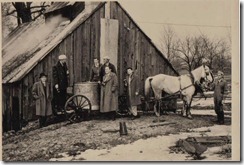V The Early Years, winter
The time is 1949 WWII that ended the depression of the ‘30’s has over for four yrs., the economy is picking up, technology is increasing with it’s prices getting cheaper so more can afford more. The location, a family dairy farm a couple miles NNW of East Farnham, nestled in the valley between 2 branches of the Yamaska River at the NW corner of Brome County in Quebec’s Eastern Townships. 45o 15’ 41.30†N 72o 47’ 45.38†W elevation 119m
Winter
A waning moon throws a pale light on the snow-covered landscape illuminating a country road passing through the pastoral countryside dotted with 100 acre dairy farms. A 5 ton Chevy truck wends its way along in the predawn moonlight road dropping off empty eight gallon milk cans, with a clatter, here and there a precursor to the start of a new day on the farm.
The ringing sound of the cans kissing each other before being deposited with a crunch in the frosty snow-covered driveway awakes 3 1/2 yr old Davey who, toasty warm in his flannelette pj’s snuggled deep under the covers, spying frost-covered window panes glistening in the moonlight knows this will be another adventure filled day.
Being located where the milk trucks route where the cans
are dropped off just before 5am makes that a good alarm clock for the start of the day on the Hawke farm. ( unbeknownst to young Davey now in years to come it will also serve as a curfew from a night of carousing, get home before the milk truck so parents don’t know when you got in, or so you think) Davey now has a half hour or so to make plans for the day as with the temperature in the minus degrees Fahrenheit on a typical January day, it takes a while for his father to get up and get a fire lit in the cook stove in the kitchen and the coal fired Quebec heater
in the front room to take the chill off the house. His grandfather must do the same with the furnace in his adjoining house as the shared bathroom is on his side, accessed by a connecting door.
A typical winters day would start by ‘helping’ with the chores, this entailed getting bundled up in snowsuit, winter boots, mittens, scarf and toque, taking a couple quick toboggan slides down the barn bridge hill with the dog on the way to the stable. Once in the stable where the heat from the animals kept it warm the mittens and scarf could be ditched. The cows would be chomping on chopped turnips
covered with dairy ration while father was milking with grandfather stripping them, father said this was unnecessary with the new McCormick-Deering milkers but it kept him happy so no harm done. The dog and so barn cats got warm milk, the cats weren’t overfed as it was their job to keep the barn rodent free and the dog also got table scraps, there was usually a calf or two to be pail fed and I was getting big enough to help with this. In between my ‘chores’ there was time to play in the haymow. When milking was done loose hay from the mow was forked into the mangers for cows to munch on during the day then father was washing up the milkers
I would help grandfather feed the chickens
and horses.
Chores done with an appetite worked up it was breakfast time, a big glass of milk, usually porridge with a bit of Jersey milk topped with maple sugar, eggs boiled or poached, bacon and I seem to remember prunes often being served followed by a teaspoon of hated cod liver oil. Father always had a dish of maple syrup as desert.
Next father went back to the barn to clean the gutters, bring in fresh sawdust and straw for bedding, brush the cows and generally keep the place tidy as the milk inspector could show up at anytime. I would observe and supervise a bit but was too small to be of much help so spent a while with the toboggan on the barn bridge hill and playing with my fleet of trucks and tractors in the snow. Had to make sure I was out of the way before the milk truck returned to pick up the full cans. I would then return to the house to see what mother and grandmother were doing, thus I honed my domestic skills to balance the outside ones.
Mid-morning every second day the bread man comes, some times mother can be talked into buying a box of jelly donuts.
As winter is a slow time of year nothing too exciting goes on in the kitchen just mundane cooking for a meat and potato diet with preserved veggies, the exception being if there was a church supper in the offing, then there would be preparations for baked beans, chicken pie with dumplings or the inevitable scalloped potato casserole to be served with baked ham. A special treat would be the odd Saturday morning spent at grandmother Mahannah’s preparing the dough for donuts, rolling it out on the flour covered cutting board, using the cutter to size them and make the hole then frying them in the big cast iron pot on the wood stove, there’s nothing like a warm freshly made donut on a cold winters day.
Now with preparations for dinner (the main meal of the day) underway it’s time for some indoor play, there’s my truck and tractor fleet, my farm animal collection, miniature tea set I can choose from to use my imagination to create unlimited scenarios or there is always a colouring book to practice my keeping within the line skills, blocks to build forts with and best of all picture books where you are transported to a different world. There is never a lack of ways to pass the time.
Dinner time, a roast or other cut of beef or on occasion pork or chicken, potatoes and veggies from the root cellar, preserves with a pie or pudding for desert. Coffee for father, tea for mother and all the Jersey milk I can drink for me, maybe add a bit of ‘Quick’ to it if I’ve been good. Accompanying dinner would be the noon CBC Farm Broadcast , this 15 minute show included the current days cattle and farm produce prices, the weather plus ongoing saga of the The Craigs comedy sketch.
After dinner in nap time for all. The afternoon could be spent in many ways, possibly a trip to town as there’s always groceries to be bought, bills to pay, friends to visit. On a lucky day there might be a trip to the garage to get something repaired. We didn’t normally travel far in those days, the general store in Adamsville for groceries, vehicle repairs also in Adamsville, Post office in East Farnham, Church in Brigham, bank and other shopping in Cowansville plus a couple trips a year to Montreal for things not available locally. (little did I know then but for the next 7 decade’s I would choose my long term residences in or in the vicinity of a small village with necessities available that was within 15 minutes of a town where most purchases could be made and under an hour from a major city) Most afternoons though were spent ‘helping’ father with outside chores, mother with her inside ones plus time in my own imaginary world.
5pm was afternoon milking time where morning chores were repeated.
Supper was a light meal at days end usually dinner left overs with possibly soup or a sandwich.
The evening would be spent listening to the radio, playing records, family board games and discussing the days events, planning future activities. I would be hustled off to bed by eight. Some nights we hosted a Farm Radio Forum or medical coop meeting and I was allowed to meet the people, in my pj’s before going upstairs to bed then I overheard their talk until the sandman whisked me off to dreamland.
This was a typical winters day 6 days a week, Sundays
barn chores were kept to the essentials after which we would jump in the ‘48 Chevrolet for the hop to the United church in Brigham followed by a visit to my grandparents farm near Farnham Center.
There were also interludes with days suffering the normal childhood diseases of chickenpox, measles etc when I was confined to the house.
Sugaring Season
In the Eastern Townships there was a period of time between the dreary n dark days of February ‘til the peeping through the snow of the first Mayflowers, it runs roughly from just prior to the Ides of March to Easter (an early Easter almost always signifies a short season) or as Peter McCarthur so eloquently penned in his poem ‘Sugar Weather’ “When the snow balls on the horses’ hoofs, And the wind from the south blows warm, — It’s off to the sugar bush I go, For the sap will run I know.
The advent of geese in the sky accompanied with steadily warming daytime temperatures means it’s (*scroll down to the poem) Sugar Weather time to head to the sugar bush, which in a good will bring in enough to pay the taxes on the farm.
The horses jittery from a long winter in their stalls are brought out, hitched to a set of double sleds commence the tiring task of breaking roads through the bush so we can get to the trees for tapping then later gathering the sap. With some creaking the doors to the sugar house are opened to reveal the stacks of buckets, the forlorn arches unused for the better part of the year. the evaporator resting against a rafter along with the other various sundries used in making of the renowned sweet syrupy substance, Quebec Maple Syrup!
Buckets loaded on the sled grandfather would follow the newly broken roads dropping buckets at every mature tree, one to four depending on the size. Father and I would follow to tap the trees (eleven hundred taps in all) with a pail full of spouts,  hammer, brace and bit stopping at each maple father would bore a hole on a slight upward angle a bit longer than the spout would penetrate I would hand him the cast-iron spout which he would tap firmly in with the hammer. Due to the shortness of my legs combined with the depth of the snow and the cumbersome snowsuit I would be plum tuckered out by the time grandfather’s sleds were empty so I would hitch ride back to the house where mother would have a cup of steaming hot chocolate waiting.
hammer, brace and bit stopping at each maple father would bore a hole on a slight upward angle a bit longer than the spout would penetrate I would hand him the cast-iron spout which he would tap firmly in with the hammer. Due to the shortness of my legs combined with the depth of the snow and the cumbersome snowsuit I would be plum tuckered out by the time grandfather’s sleds were empty so I would hitch ride back to the house where mother would have a cup of steaming hot chocolate waiting.
As this road making and tapping had to be fitted in between milking, other barn chores, cleaning and preparing the sugar house, the better part of a week would be spent on the preparations. First the 10 ft evaporator pan 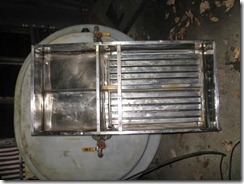 (the pic is of a small unit with the evaporator pan and finishing pan combined) have to be washed and set on the arch, a job requiring at least three people this is followed by the 4 ft square finishing pan which must be plumbed to it then the sap holding tank cleaned and plumbed into the evaporator. A couple 5 gal. cream cans to hold the syrup from the finishing pan were cleaned, a couple leaky old sap buckets had the bottoms cut out made excellent funnels for the hot syrup coming off the finishing pan into the cream cans, felt strainers inserted in these buckets were held in place with clothes pins to filter the nitre out of the finished syrup. All that remained was to string a very long extension cord from the garage to the sugar house for lights and the radio which at noon would be tuned to the CBC for the noon Farm Report followed by the latest adventures of ‘The Craigs’, otherwise it was tuned to
(the pic is of a small unit with the evaporator pan and finishing pan combined) have to be washed and set on the arch, a job requiring at least three people this is followed by the 4 ft square finishing pan which must be plumbed to it then the sap holding tank cleaned and plumbed into the evaporator. A couple 5 gal. cream cans to hold the syrup from the finishing pan were cleaned, a couple leaky old sap buckets had the bottoms cut out made excellent funnels for the hot syrup coming off the finishing pan into the cream cans, felt strainers inserted in these buckets were held in place with clothes pins to filter the nitre out of the finished syrup. All that remained was to string a very long extension cord from the garage to the sugar house for lights and the radio which at noon would be tuned to the CBC for the noon Farm Report followed by the latest adventures of ‘The Craigs’, otherwise it was tuned to 
As the weather warms the trees sap starts dripping 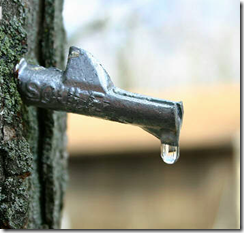 into the buckets the team is hooked to the sleds each tree is visited to empty the contents of it’s buckets into a 5 gallon pail to fill the 120 gallon gathering tank in the sled. Once full a trip
into the buckets the team is hooked to the sleds each tree is visited to empty the contents of it’s buckets into a 5 gallon pail to fill the 120 gallon gathering tank in the sled. Once full a trip 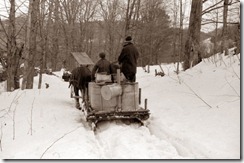 to the sugar house, where a hill has been made so the gathering tank’s outlet hose will be higher than the sides of the holding tank. On arrival an access door is removed, an end of portable trough going to the storage tank is placed on the wagon, the discharge hose gathering tank lowered into the trough and the season’s first load of sap starts gushing into the tank.
to the sugar house, where a hill has been made so the gathering tank’s outlet hose will be higher than the sides of the holding tank. On arrival an access door is removed, an end of portable trough going to the storage tank is placed on the wagon, the discharge hose gathering tank lowered into the trough and the season’s first load of sap starts gushing into the tank.
Once storage tank has adequate sap father would lay a fire in the arch that held 4ft lengths of wood,the sap would enter the evaporator pan from the storage tank wending it’s way back and forth through the pan’s channels as it increasingly hotter with each pass as it starts to steam impurities will surface in a foam which are removed with a skimmer (a dipper with screened holes) should the foam start to overflow the pan, a small bottle of milk with holes in the lid is kept handy as a few drops of milk will calm the foaming and make it magically disappear. During this process 39 gallons of water will be evaporated out the vents for every gallon of syrup produced. A valve is opened allowing the thickening liquid to leave the evaporating pan and enter the front finishing pan where the science that says maple sap becomes maple syrup at 219 degrees Fahrenheit becomes an art with the cook determines exact texture, colour and taste by his experienced eye. As the thermometer gradually climbs to the 219oF mark experience tells when to add lighter wood to the front of the arches fire to make it hotter, a dipper is then used to check the consistency of the syrup as it flows off, when the flow is just right the drain spout is lowered, the fire dampened, the dipper in constant use until the syrup thins ant the spout raised.
On a day when the sap isn’t running due to cooler temperatures or in the evening of a slow run day we can the syrup for storage and shipping, quart tins purchased from Cowansville Hardware are laid out in a row on the bench, father pours the syrup from the milk cans into a gallon pitcher fills each can to the brim then I place a lid on the can, father places each can in the canning machine 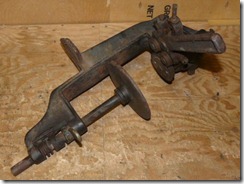 slowly turning the crank which rotates the can while applying increasing pressure to the lever that folds the lip of the lid over the can then pushing the lever the other way to complete the seal in another couple rotations. Later the cans to be sold will have printed labels saying Pure Maple Syrup S. T. Hawke East Farnham Que. wrapped around the can with a mucilage glue holding them in place.
slowly turning the crank which rotates the can while applying increasing pressure to the lever that folds the lip of the lid over the can then pushing the lever the other way to complete the seal in another couple rotations. Later the cans to be sold will have printed labels saying Pure Maple Syrup S. T. Hawke East Farnham Que. wrapped around the can with a mucilage glue holding them in place.
With the coming of Easter signifying the end of the season brings the best part of the season, relatives from far and near congregate at the farm for Easter dinner followed by a visit to the bush, where a wagon with a 6 inch covering of snow awaits, for the tasty treat sugar on snow 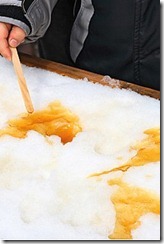 made from late season syrup.This is made taking the darker third grade syrup, poured into a 4x3ft pan placed on a smaller arch heating it up to 230oF the gallon pitcher filled then poured onto the snow on the wagon where all gather round to pig out on the once a year treat.
made from late season syrup.This is made taking the darker third grade syrup, poured into a 4x3ft pan placed on a smaller arch heating it up to 230oF the gallon pitcher filled then poured onto the snow on the wagon where all gather round to pig out on the once a year treat.
The remaining syrup in the pan is heated further to 2420F allowed to cool down to 155oF then constantly stirred to the consistency of sugar, scooped into quart cans, sealed and labeled Soft Sugar. If desired a further heating to 245oF will produce Hard Sugar which is formed into bricks or put into moulds to make Maple Sugar Candies.
Anyone wanting to tap the maple in the back yard can find a wealth of information here
Following Easter the last runs and boiling over the wrap-up of the season begins on bare ground now we traipse through the bush pulling spouts from the budding maples as the birds chirp overhead. Stacking buckets by the roads through the woods dotted by pockets of pinkish-white Mayflowers  as the crows caw in the distance. The woods are alive now, not only overhead with new life in the trees but also on the ground a if i am quiet and listen closely I can hear a mouse scurrying through the dead leaves in search of dinner. Coming close to a copse of evergreens a partridge drums it’s wings. We will return tomorrow with the team and wagon which replaced the sleds as the snow disappeared from the bush roads.
as the crows caw in the distance. The woods are alive now, not only overhead with new life in the trees but also on the ground a if i am quiet and listen closely I can hear a mouse scurrying through the dead leaves in search of dinner. Coming close to a copse of evergreens a partridge drums it’s wings. We will return tomorrow with the team and wagon which replaced the sleds as the snow disappeared from the bush roads.
With the #1 & #2 grade syrup plus the soft sugar canned, labelled and moved to a storage shed at the house, the year end dark syrup in a 45 gallon drum for shipment to le Fédération des producteurs acéricolesde Québec to be sold for commercial use, only clean up remains, a small fire is made in the arch, a couple gallons of remaining warm sap in the evaporator pan is used to top up the wooden barrel of maple vinegar. Both pans are then thoroughly washed with hot water, drained, the plumbing disconnected and stored. A gathering tank load of water run into the storage tank so it can be scrubber clean of any sticky sap residue before also being drained.
With the evaporator pan manhandled back into it’s resting place against the rafter, finishing pan nestled by it’s side by it’s side, the ash removed from the arch, a fair days work has been done.
The next warm sunny day the bucket washing takes place. A final gathering tank of water is brought down, a fire made in the small sugaring off arch heating the pan full of water which is then paled to the bucket washer  outside where the stacks of 1,100+ buckets await in the now empty wood shed. Father dons his mid-arm length rubber gloves (the water is hot) takes a bucket from the pile washes it, holds it up to the sun checking for then hands it off to be placed on the grass to be dried by the sun, buckets needing repair are placed in a separate location, this is a job I can help with. Buckets, spouts, dippers all washed we call it a day.
outside where the stacks of 1,100+ buckets await in the now empty wood shed. Father dons his mid-arm length rubber gloves (the water is hot) takes a bucket from the pile washes it, holds it up to the sun checking for then hands it off to be placed on the grass to be dried by the sun, buckets needing repair are placed in a separate location, this is a job I can help with. Buckets, spouts, dippers all washed we call it a day.
Lastly we return to the sugar house to pick up the clean buckets, stack them in their place inside, other utensils put in their place, bucket washer and gathering tank in their place also inside the sugar house. With the buckets in need of repair are loaded on the wagon, along with the radio, the extension cord rolled up, Sugar Season is over for another year.
The leaks buckets will be soldered on a rainy day as now there is Springs work to be done!
Tags: Dave's Autobiography


